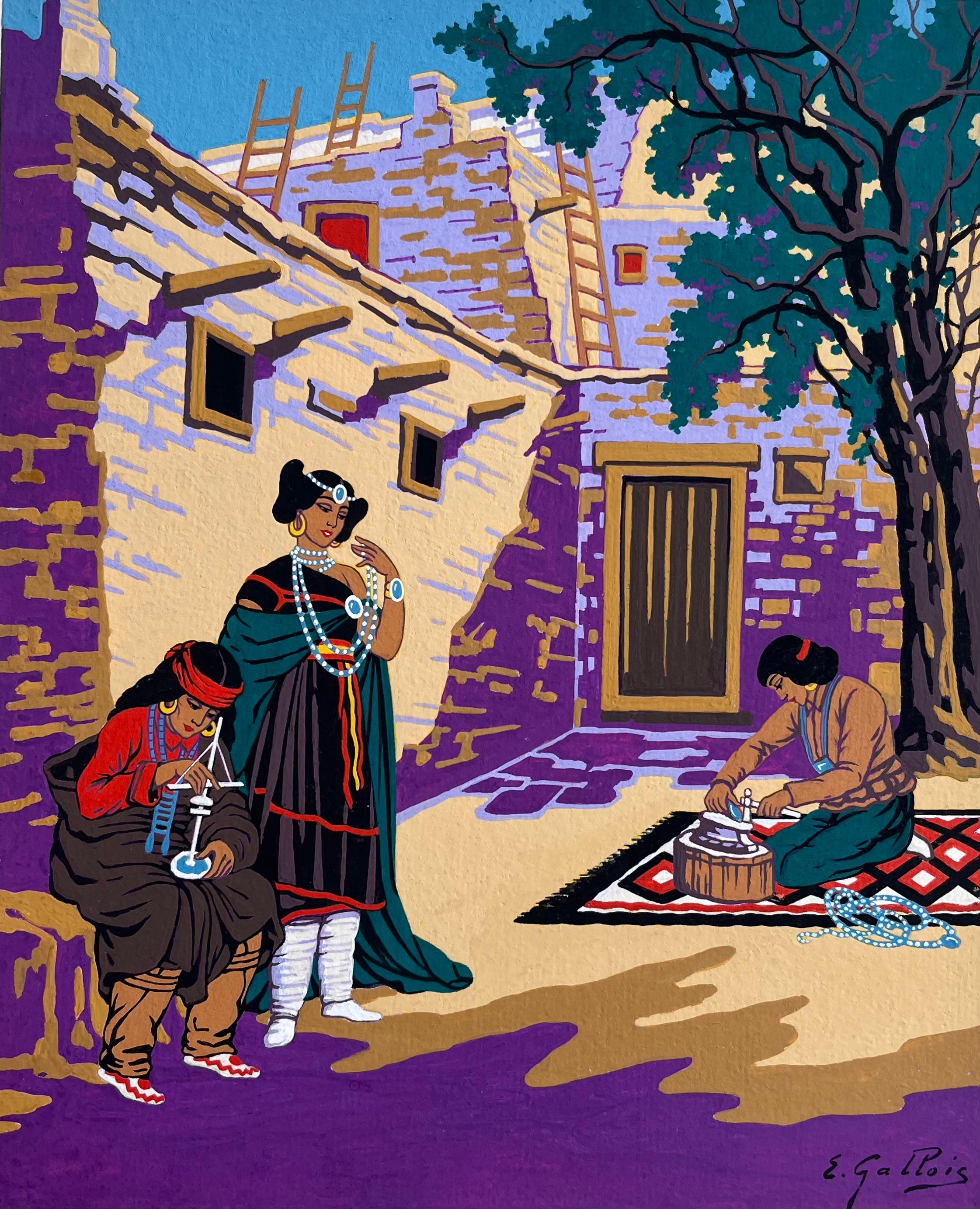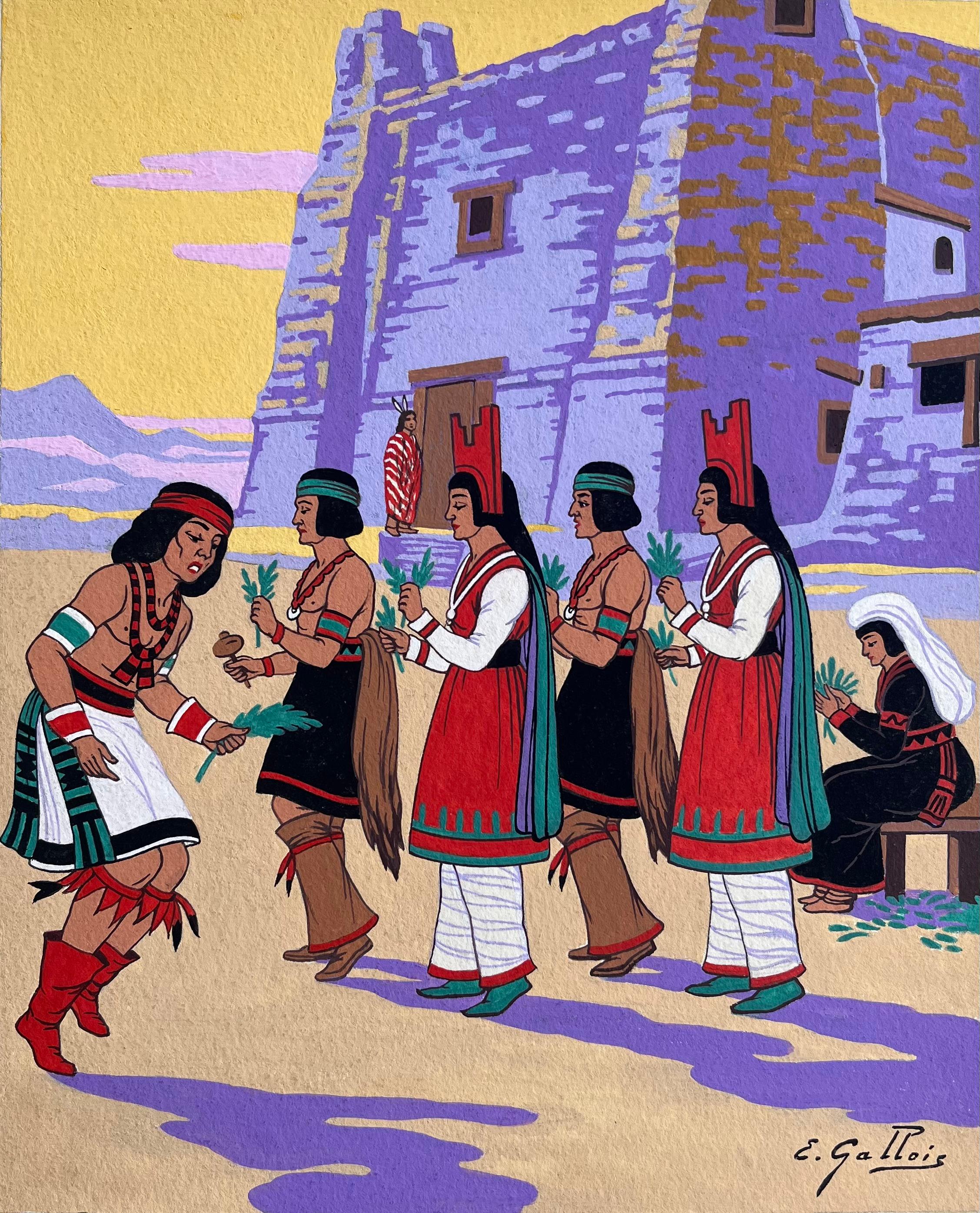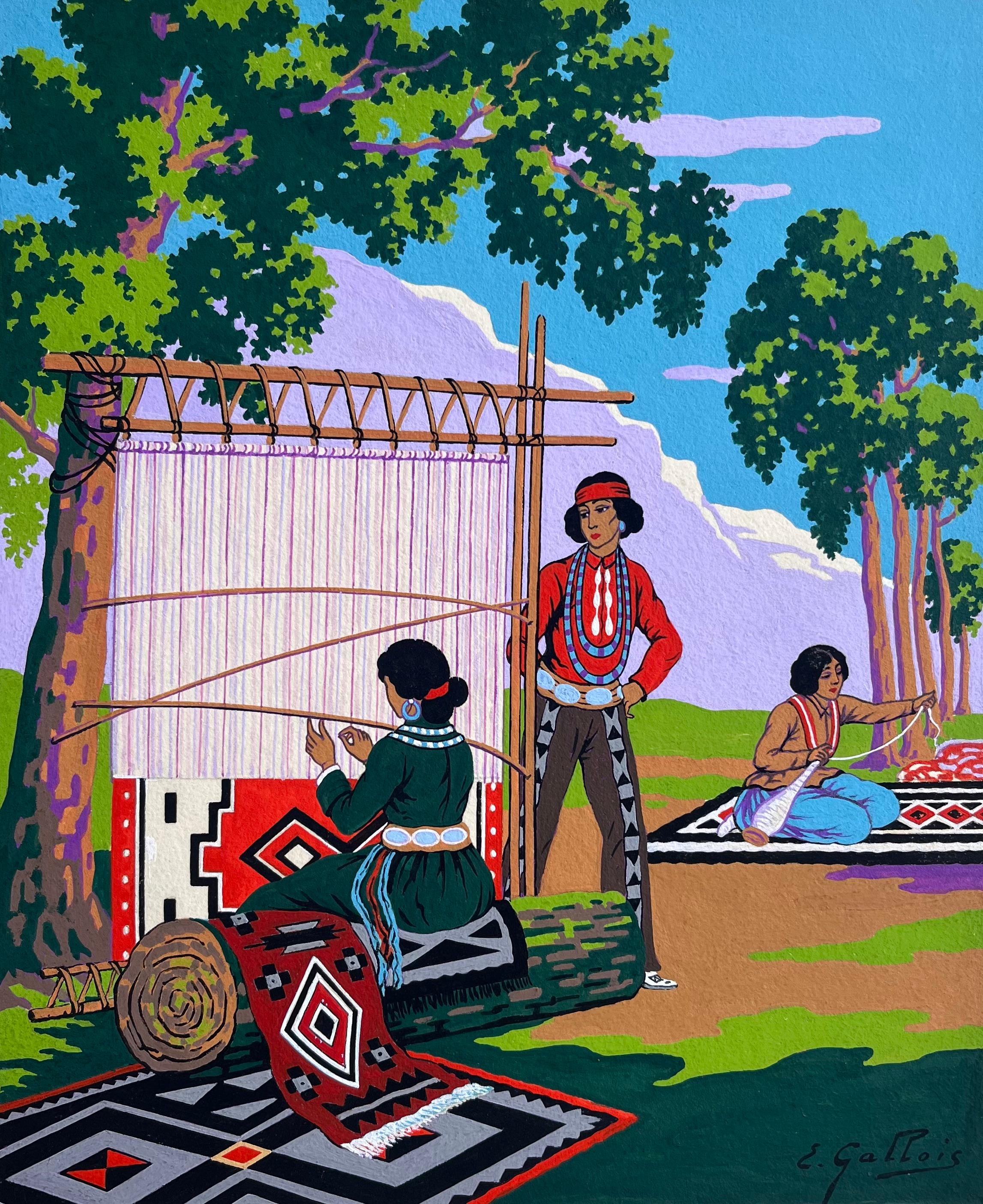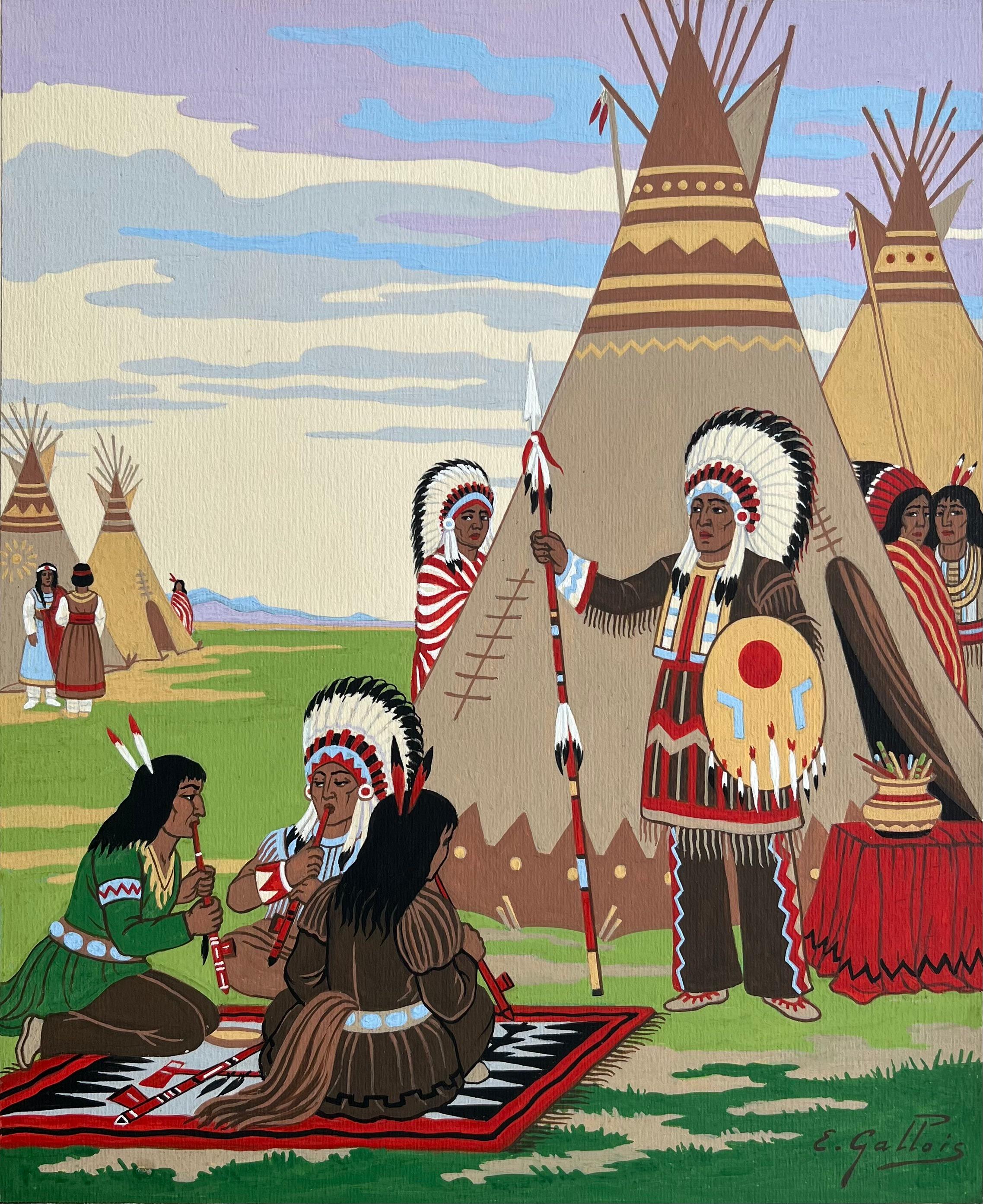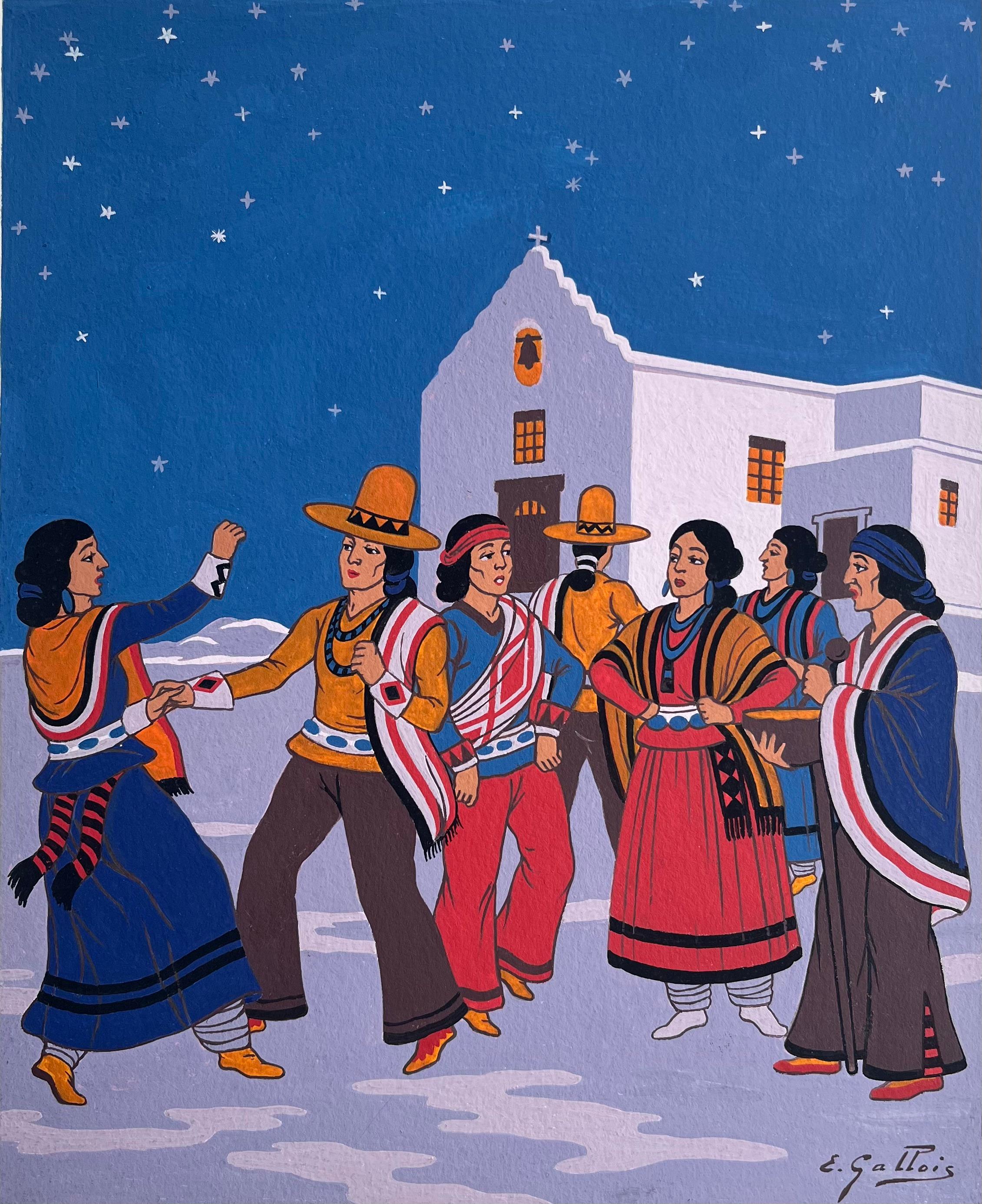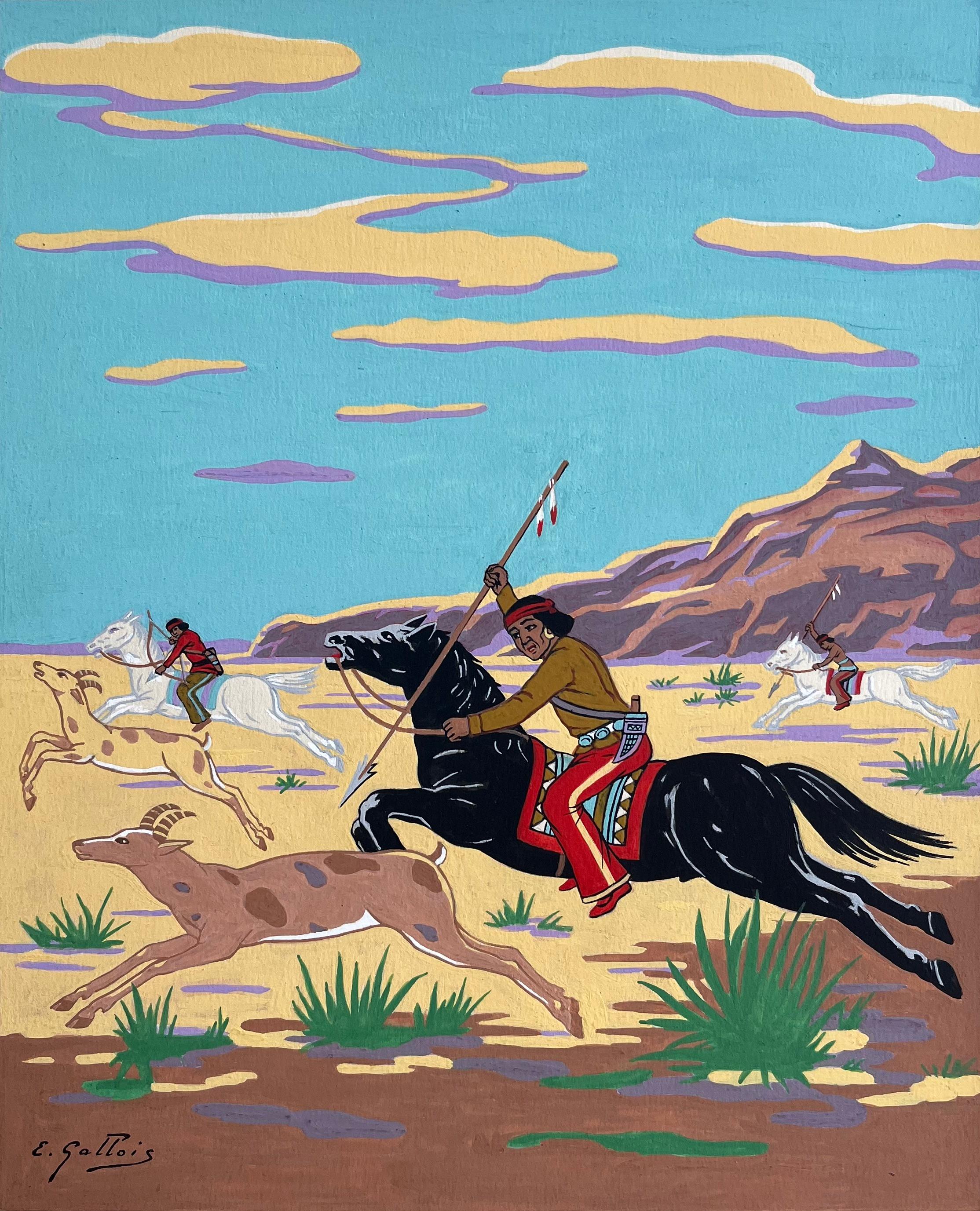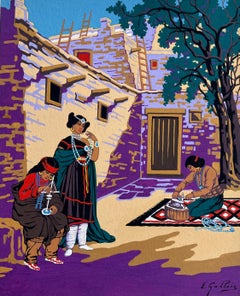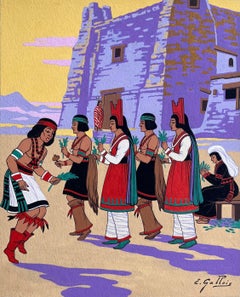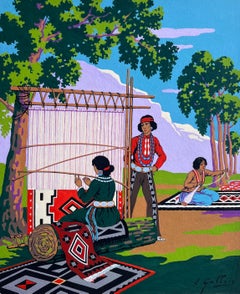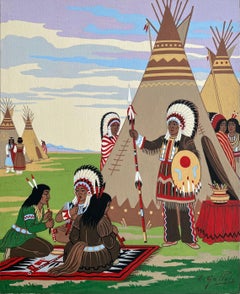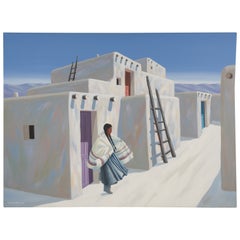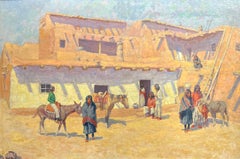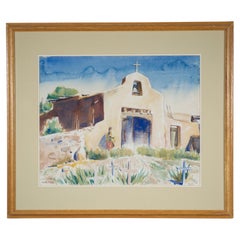Items Similar to French Gouache Painting of Pueblo Bread Baking in Taos New Mexico
Want more images or videos?
Request additional images or videos from the seller
1 of 11
Emile GALLOIS (1882-1965)French Gouache Painting of Pueblo Bread Baking in Taos New Mexico
$735.85
£540
€636.44
CA$1,012.74
A$1,128.80
CHF 592.24
MX$13,784.48
NOK 7,499.07
SEK 7,087.77
DKK 4,750.06
About the Item
Title: French Gouache Painting of Pueblo Bread Baking in Taos New Mexico
by Emile GALLOIS (1882-1965, French)
Signed: Yes
Medium: Original gouache painting on thick unframed paper,
Size: 13.75 inches (height) x 11 inches (depth)
Conditon: Very good
Provenance: From a private French collection
Description:
This beautifully detailed gouache painting by Emile Gallois (1882-1965) captures a traditional bread-making scene in Taos Pueblo, New Mexico, where women prepare and bake loaves in an outdoor adobe horno (oven). The composition showcases the daily life and community spirit of the Pueblo people, set against the backdrop of historic multi-storied adobe homes with ladders and colorful doorways.
Key features:
Cultural & Historical Representation: A vibrant depiction of Pueblo women preparing and baking bread using a traditional horno oven, an essential practice in Indigenous Southwestern communities.
Authentic Puebloan Attire: The women are dressed in beautifully embroidered garments with geometric patterns, long shawls, and decorative jewelry, reflecting the rich textile traditions of the Pueblo people.
Warm & Lively Color Palette: The golden adobe walls, deep reds, rich blues, and bright sky create a striking contrast that enhances the visual warmth of the scene.
Intricate Detailing: The oven’s texture, woven blankets, patterned rugs, and expressive gestures bring depth and authenticity to the artwork.
Collector’s Appeal: A perfect addition for collectors of Southwestern art, Native American daily life scenes, ethnographic studies, and early 20th-century illustration.
Gallois, a renowned French Impressionist and illustrator, exhibited widely at the Salon des Indépendants in Paris and was celebrated for his ethnographic studies of Indigenous cultures worldwide. This piece offers a rare and intimate glimpse into the traditions of the Taos Pueblo, making it an exceptional and historically valuable work.
- Creator:Emile GALLOIS (1882-1965) (1882 - 1965, French)
- Dimensions:Height: 13.75 in (34.93 cm)Width: 11 in (27.94 cm)Depth: 1 in (2.54 cm)
- Medium:
- Movement & Style:
- Period:
- Condition:
- Gallery Location:Cirencester, GB
- Reference Number:1stDibs: LU509315973622
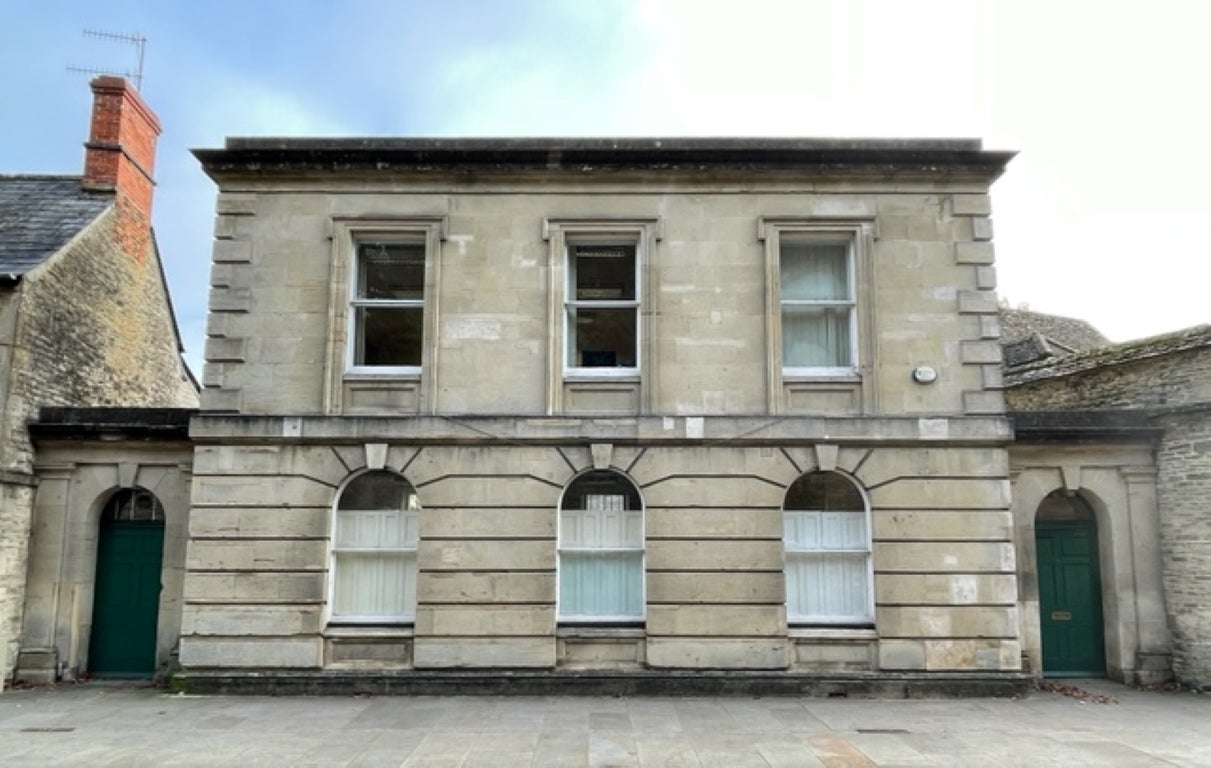
About the Seller
5.0
Platinum Seller
Premium sellers with a 4.7+ rating and 24-hour response times
Established in 1989
1stDibs seller since 2016
4,646 sales on 1stDibs
Typical response time: 1 hour
- ShippingRetrieving quote...Shipping from: Cirencester, United Kingdom
- Return Policy
Authenticity Guarantee
In the unlikely event there’s an issue with an item’s authenticity, contact us within 1 year for a full refund. DetailsMoney-Back Guarantee
If your item is not as described, is damaged in transit, or does not arrive, contact us within 7 days for a full refund. Details24-Hour Cancellation
You have a 24-hour grace period in which to reconsider your purchase, with no questions asked.Vetted Professional Sellers
Our world-class sellers must adhere to strict standards for service and quality, maintaining the integrity of our listings.Price-Match Guarantee
If you find that a seller listed the same item for a lower price elsewhere, we’ll match it.Trusted Global Delivery
Our best-in-class carrier network provides specialized shipping options worldwide, including custom delivery.More From This Seller
View AllVibrant French Gouache Painting of Navajo Jewelry Makers in Albuquerque
Located in Cirencester, Gloucestershire
Title: Vibrant French Gouache Painting of Navajo Jewelry Makers in Albuquerque
by Emile GALLOIS (1882-1965, French)
Signed: Yes
Medium: Original gouache painting on thick unframed p...
Category
Mid-20th Century American Modern Figurative Drawings and Watercolors
Materials
Gouache
French Gouache Painting of Acoma Pueblo Corn Dance in New Mexico
Located in Cirencester, Gloucestershire
Title: French Gouache Painting of Acoma Pueblo Corn Dance in New Mexico
by Emile GALLOIS (1882-1965, French)
Signed: Yes
Medium: Original gouache painting on thick unframed paper,
Si...
Category
Mid-20th Century American Modern Figurative Drawings and Watercolors
Materials
Gouache
French Gouache Painting of Navajo Weavers in Canyon de Chelly Arizona
Located in Cirencester, Gloucestershire
Title: French Gouache Painting of Navajo Weavers in Canyon de Chelly Arizona
by Emile GALLOIS (1882-1965, French)
Signed: Yes
Medium: Original gouache painting on thick unframed pape...
Category
Mid-20th Century American Modern Figurative Drawings and Watercolors
Materials
Gouache
French Gouache Painting of Indigenous Council Gathering in Colorado Nevada
Located in Cirencester, Gloucestershire
Title: French Gouache Painting of Indigenous Council Gathering in Colorado Nevada
by Emile GALLOIS (1882-1965, French)
Signed: Yes
Medium: Original gouache painting on thick unframed...
Category
Mid-20th Century American Modern Figurative Drawings and Watercolors
Materials
Gouache
French Gouache Painting of Navajo Night Dance in New Mexico
Located in Cirencester, Gloucestershire
Title: French Gouache Painting of Navajo Night Dance in New Mexico
by Emile GALLOIS (1882-1965, French)
Signed: Yes
Medium: Original gouache painting on thick unframed paper,
Size: 1...
Category
Mid-20th Century American Modern Figurative Drawings and Watercolors
Materials
Gouache
French Gouache Painting of Native American Antelope Hunt in Utah
Located in Cirencester, Gloucestershire
Title: French Gouache Painting of Native American Antelope Hunt in Utah
by Emile GALLOIS (1882-1965, French)
Signed: Yes
Medium: Original gouache painting on thick unframed paper,
Si...
Category
Mid-20th Century American Modern Figurative Drawings and Watercolors
Materials
Gouache
You May Also Like
Deborah Hiatt, acrylic on canvas painting, Pueblo Indian Scene, 1987
Located in Clifton Springs, NY
Deboah Hiatt, born in 1953 in Bethlehem, Pennsylvania, died in 2013 in Scottsdale, Arizona, was a renown painter of Southwest and Pueblo Indian imagery. She frequently visited Pueblos and Cliff dwellings, finding a continuing source of inspiration in living history of ceremonial dances, powwows, and traditional way of life. Her paintings celebrated Native-American society with profound sense of serenity and spirituality conveyed through respectful interpretation of the subject and careful, thoughtful choices of colors.
Hiatt majored in the visual arts and art history at Moore College of Arts in Philadelphia; she was a member of Arizona Artists Guild, Arizona Watercolor Association, and associate member of American Watercolor Society. She painted in many mediums, including acrylic and oil on canvas, watercolor, and mixed media.
The painting measures 48in by 36in by 1.5in. It is signed by the artist in lower left corner "Deborah Hiatt...
Category
Vintage 1980s American Paintings
Materials
Canvas, Acrylic
'Navajo Family', Santa Fe, Modernism, Corcoran, Whitney, PAFA, AIC, WPA
By Eduard Buk Ulreich
Located in Santa Cruz, CA
Signed lower center, 'by Buk' for Eduard Buk Ulreich (American, 1889-1966), dedicated lower center, 'for Ruth' and painted circa 1945. Additionally signed and titled verso 'Navajo Fa...
Category
1940s Art Deco Figurative Drawings and Watercolors
Materials
Illustration Board, Gouache, Watercolor
Mid-day, Zuni Village
By Frank Reed Whiteside
Located in Missouri, MO
Mid-day, Zuni Village, 1897
By. Frank Reed Whiteside (American, 1866-1929)
Unframed: 20" x 30"
Framed: 28" x 38"
Frank Reed Whiteside, born in Philadelphia on 20 August 1867, became a student of Thomas Anshutz at the Pennsylvania Academy of the Fine Arts (1888-92). He already began exhibiting there during his student years (1887-98). In 1893, he enrolled in the Académie Julian in Paris where he received instruction from Jean-Paul Laurens and Benjamin Constant. After his French academic training, Whiteside taught art in Philadelphia high schools. He took frequent trips to the Southwest between 1890 and 1928 to live with and paint the Zuni Indians. Whiteside depicted ceremonial dances, Zuni buildings, and other genre scenes, usually in blinding afternoon sunlight. He carefully observed the effects of light on vibrant color, using a finely crafted impressionist technique. He was fond of broad areas of color, subtle combinations of hues, and simplified shapes and silhouettes. Whiteside continued to exhibit at the PAFA (1905-15), at the Art Institute of Chicago (1896-1916), at the Carnegie International (1905 and 1907) and at the Corcoran Gallery (1907). He was a member of Philadelphia art societies and beginning in 1909 had a summer studio in Ogunquit, Maine, where he took part in Hamilton Easter Field's discussion groups. Frank's wife, Clara Walker Whiteside, who published Touring New England in 1926, was active in the Ogunquit Art Association.
Like Stanford White, Frank Reed Whiteside was the victim of murder, on 19 September 1929, but Whiteside's case remains unsolved. One night, the sixty-three year-old painter answered the doorbell. Two witnesses...
Category
Late 19th Century Other Art Style Figurative Paintings
Materials
Canvas, Oil
Price Upon Request
Ralph Avery New Mexico Scene, Watercolor Painting, Circa 1938-41
Located in Clifton Springs, NY
Vintage watercolor painting features a scene in New Mexico with a female figure leaning on the wall of a church.
The painting is signed by the artist in lower left corner; it has its original frame with handwritten note attached to the brown paper backing - Ralph Avery...
Category
Early 20th Century Paintings
Materials
Paper
'Taos Placita' — American Southwest Regionalist Masterwork
By Gustave Baumann
Located in Myrtle Beach, SC
Gustave Baumann, 'Taos Placita', color woodcut, 1947, edition 125. Baumann 132. Signed, titled, and numbered '20-125' in pencil; with the artist’s Hand-in-Heart chop. A superb, richly-inked impression, with fresh colors, on fibrous oatmeal wove paper; the full sheet with margins (2 to 3 1/8 inches); slight rippling at the left sheet edge, in excellent condition. Matted to museum standards, unframed.
Image size 9 5/8 x 11 1/4 inches (244 x 286 mm); sheet size 13 1/4 x 17 inches (337 x 432 mm).
Collections: New Mexico Museum of Art, Phoenix Art Museum, Wichita Art Museum.
ABOUT THE ARTIST
Gustave Baumann (1881-1971) was a renowned printmaker and a leading figure of the American color woodcut revival whose exquisite craftsmanship and vibrant imagery captured the essence of the Southwest.
"A brilliant printmaker, Baumann brought to the medium a full mastery of the craft of woodworking that he acquired from his father, a German cabinetmaker. This craftsmanship was coupled with a strong artistic training that resulted in the handsome objects we see in the exhibition today. After discovering New Mexico in 1918, Baumann began to explore in his woodblock prints of this period the light. color, and architectural forms of that landscape. His prints of this period are among the most beautiful and poetic images of the American West."
—Lewis I. Sharp, Director, Denver Art Museum
Baumann, the son of a craftsman, immigrated to the United States from Germany with his family when he was ten, settling in Chicago. From 1897 to 1904, he studied in the evenings at the Art Institute of Chicago, working in a commercial printmaking shop during the day. In 1905, he returned to Germany to attend the Kunstwerbe Schule in Munich, where he decided on a career in printmaking. He returned to Chicago in 1906 and worked for a few years as a graphic designer of labels.
Baumann made his first prints in 1909 and exhibited them at the Art Institute of Chicago the following year. In 1910, he moved to the artists’ colony in Nashville, Indiana, where he explored the creative and commercial possibilities of a career as a printmaker. In 1915, he exhibited his color woodcuts at the Panama-Pacific International Exposition in San Francisco, winning the gold medal.
Among Baumann’s ongoing commercial activities was his work for the Packard Motor Car Company from 1914 to 1920 where he produced designs, illustrations, and color woodcuts until 1923.
In 1919, Baumann’s printmaking work dominated the important exhibition of American color woodcuts at the Detroit Institute of Arts. Twenty-six of his prints were included, far more than the works of any other artist. A set of his blocks, a preparatory drawing, and seven progressive proofs complemented the exhibition. That same year, Baumann worked in New York and, over the summer, in Provincetown, Massachusetts. His airy images of Cape Cod employed soft, pastel colors and occasionally showed the influence of the white-line woodcut technique.
Many of his Chicago artist friends had traveled to the southwest, and Baumann became intrigued by their paintings, souvenirs, and stories of an exotic place named Taos, New Mexico. In the summer of 1918, he spent the summer in Taos sketching and painting before visiting Santa Fe. Paul Walter, the director of the Museum of New Mexico, offered him a studio in the museum's basement. Inspired by the rugged beauty of the Southwest—the vibrant colors and dramatic landscapes of the region became a central theme in his work, influencing his artistic style and subject matter for the remainder of his career. Later in the decade, he traveled to the West Coast and made prints of California landscape.
Baumann's prints became synonymous with the Southwest, capturing the spirit of its place in America's identity with a unique sense of authenticity and reverence. His iconic images of desert vistas, pueblo villages, and indigenous cultures served as visual tributes to the region's rich cultural heritage, earning him a dedicated following among collectors and curators alike.
A true craftsman and artist, Baumann completed every step of the printmaking process himself, cutting each block, mixing the inks, and printing every impression on the handmade paper he selected. His dedication to true craftsmanship and his commitment to preserving the integrity of his artistic vision earned him widespread acclaim and recognition within the art world. About the vibrant colors he produced, Baumann stated, “A knowledge of color needs to be acquired since they don’t all behave the same way when ground or mixed...careful chemistry goes into the making of colors, with meticulous testing for permanence. While complicated formulae evolve new colors, those derived from Earth and metal bases are still the most reliable.”
In the 1930s, Baumann became interested in puppet theater. He designed and carved his own marionettes and established a little traveling company. From 1943 to 1945, the artist carved an altarpiece for the Episcopal Church of the Holy Faith in Santa Fe. In 1952, a retrospective exhibition of his prints was mounted at the New Mexico Museum of Fine Arts. Throughout his prolific career, Baumann executed nearly four hundred color woodcuts.
Baumann’s woodcuts...
Category
1940s American Modern Landscape Prints
Materials
Woodcut
Spoils from Mexico, American Western Art Gouache Painting by Noel Daggett
By Noel Daggett
Located in Long Island City, NY
Noel Daggett, American (1925 - 2005) - Spoils from Mexico (Apache), Year: 1988, Medium: Gouache on Board, signed and dated, Size: 13 in. x 10 in. (33.02 cm x 25.4 cm), Frame Size:...
Category
1980s American Realist Drawings and Watercolor Paintings
Materials
Gouache
More Ways To Browse
New Mexico Paintings
Southwestern Art
Mexican Vibrant Painting
Textile Art Mexico
Taos New Mexico
Taos New Mexico Art
Taos Modern
Pueblo Art
Bread Painting
Southwestern Art New Mexico
Mexican Gouache
Pueblo Painting
Mexican Blankets
Taos Moderns Paintings
Southwestern Watercolor Paintings
Vintage Native American Dress
Southwestern Blanket
Mexican Woven Blanket
